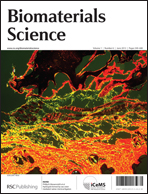At present the scaffolds used for bioprinting of cells do not elicit morphogenetic responses in the cells. In the present study we approached a solution by studying the effect of an inorganic silica supplement added to an Na-alginate matrix. Bone- and osteoblast-like SaOS-2 cells were embedded into this organic polymeric matrix which was additionally enriched with 400 μM prehydrolyzed TEOS [tetra-ethoxy-silane], a source of ortho-silicate. In this silica-based matrix the cells synthesized hydroxyapatite crystallites after exposure to a mineralization activation cocktail composed of β-glycerophosphate, ascorbic acid and dexamethasone. The degree of hydroxyapatite synthesis, determined by staining the cells with the OsteoImage dye, strongly increased after exposure of the cells to silica. In a previous study we reported that ortho-silicate induces the expression of the gene encoding BMP-2 [bone morphogenetic protein-2]. Now we asked the question whether, in the presence of the mineralization activation cocktail, silica induces differentially the fibrillar proteins type I collagen [COLI] and type V collagen [COLV], as well as the non-collagenous proteins alkaline phosphatase [ALP], osteopontin [OPN], osteonectin [ON], osteocalcin [OC], and bone sialoprotein II [BSP]. Those expression values were correlated with the transcript levels of RUNX2 [Runt-related transcription factor 2]. The data show that the steady-state transcript level of RUNX2 remained unchanged in the presence of silica, while this inorganic polymer caused an elevated BMP-2 transcript level, and simultaneously also a significant upregulation of the COLI, COLV, OPN and ON genes. In contrast, the level of expression of OC and BSP remained unchanged in the presence of silica. It is concluded that silica causes its morphogenetic effect with respect to some bone-specific genes, COLI, COLV, OPN and ON, in a RUNX2-independent way.


 Please wait while we load your content...
Please wait while we load your content...